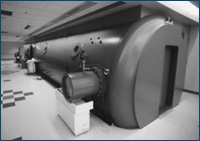Shirelle Smith
 The hyperbaric chamber can treat as many as 24 patients in one 90-minute period. Shock Trauma's chamber is the largest in the country.
The hyperbaric chamber can treat as many as 24 patients in one 90-minute period. Shock Trauma's chamber is the largest in the country.
Shirelle Smith couldn't remember where she had put her baby. On a cold December morning, lightheaded, confused and extremely weak, she staggered through the upstairs rooms of her home, looking for Taujma, her five-week old infant.
When she finally found her, safely lying on the bed, Shirelle didn't have the strength to carry the child down the stairs, but she knew she had to get help-- the baby was not waking up.
So Shirelle wrapped Taujma in a thick blanket, held her tightly, and slid down the steps. Then she crawled along the floor to the telephone and dialed 911. The paramedics arrived quickly, administered oxygen to mother and child and took them to a hospital where a blood test confirmed what Shirelle had suspected--exposure to carbon monoxide.
After three hours of oxygen treatment, Shirelle and her baby were sent to the Shock Trauma Center for hyperbaric oxygen therapy. During hyperbaric oxygen therapy, pure oxygen is given to patients in a specially constructed chamber under increased atmospheric pressure. The increased pressure in the chamber allows the body to absorb oxygen more quickly. Used primarily for carbon monoxide poisoning, smoke inhalation, diving accidents and crush injuries, hyperbaric oxygen therapy also helps people with wounds that are not healing properly, burns and injuries related to radiation therapy.
The hyperbaric chamber at the Shock Trauma Center can hold up to 24 patients, in addition to medical support staff. Because of the quality of its treatment, ongoing research and excellent staff, the chamber is acknowledged as one of the premier hyperbaric facilities in the United States. And it is the only hospital-based clinical chamber in Maryland capable of treating more than one person at a time.
Although their lives were not in jeopardy when they reached Shock Trauma, Shirelle and Taujma were treated in the hyperbaric chamber to prevent future problems. Research has shown that people exposed to carbon monoxide may later develop neurologic symptoms, including persistent headaches and memory loss. Hyperbaric treatment can often prevent this.
For 45 minutes, Shirelle and Taujma, accompanied by a nurse, breathed the pure oxygen of the hyperbaric chamber. "I could feel myself coming back to life," Shirelle recalled. "My limbs started feeling lighter. And I could carry on a conversation."
Upon emerging from the chamber, Shirelle was given a neuro-psychology test, which indicated she had no problems with confusion or memory loss. After resting at home for two days, she went back to work. Today, Shirelle reports no effects of the carbon monoxide exposure. Taujma is growing and developing into a happy, outgoing child. And the team of specialists in the hyperbaric department at the Shock Trauma Center continues to be ready 24 hours a day, seven days a week, to seal the doors of the chamber and "pressurize" for anyone who needs it.
